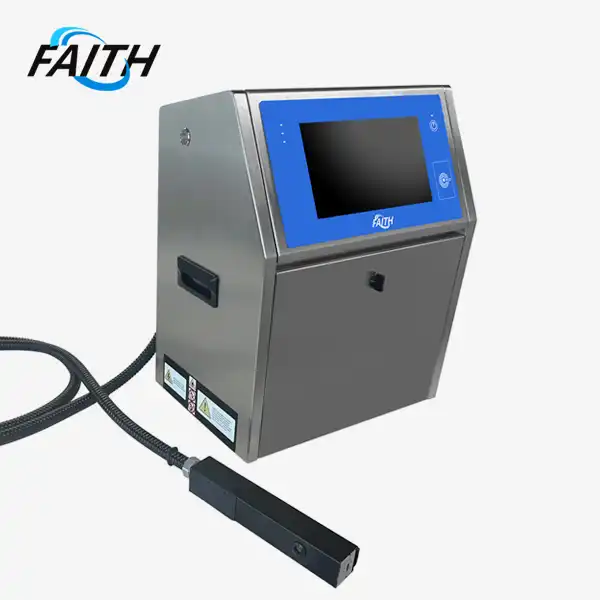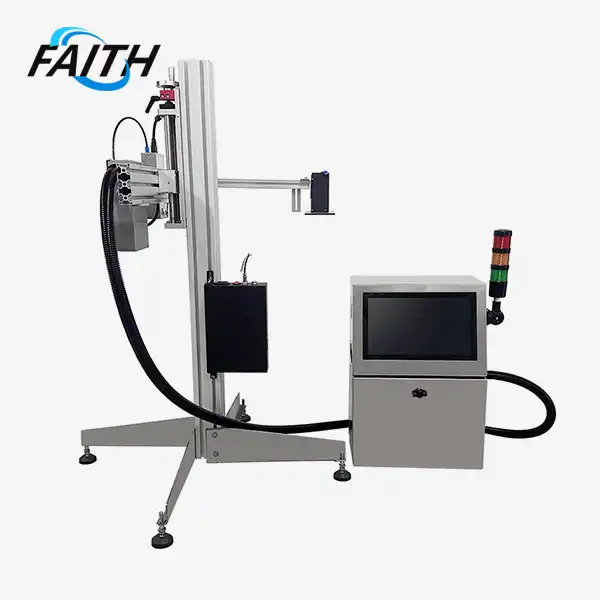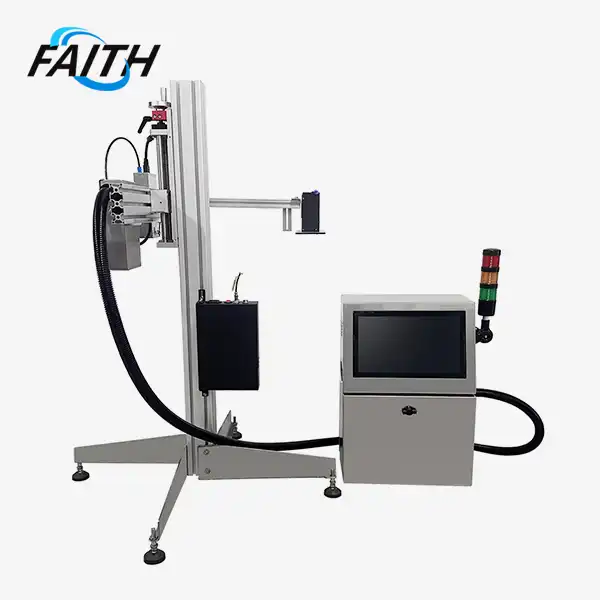How to Choose the Best Wholesale CIJ Printer for Your Business?
Selecting the ideal wholesale continuous inkjet printing solution for your business requires careful consideration of several key factors. To make the best choice, evaluate your specific printing needs, including production volume, substrate materials, and required print quality. Consider the printer's speed, versatility, and ability to handle various ink types. Assess the machine's durability, maintenance requirements, and overall cost-effectiveness. Additionally, factor in the manufacturer's reputation, after-sales support, and customization options. By thoroughly examining these aspects, you can identify a CIJ printer that aligns perfectly with your operational demands, enhancing productivity and ensuring consistent, high-quality coding across your product lines.
Introducing the Fundamentals of Wholesale CIJ Printing Technology
Continuous inkjet (CIJ) printing technology has revolutionized industrial coding and marking processes across various sectors. This non-contact printing method offers unparalleled versatility and efficiency, making it an indispensable tool for businesses seeking reliable product identification solutions. Faith printers operate by generating a continuous stream of ink droplets, which are selectively charged and deflected to create precise characters and images on a wide range of substrates.
One of the most significant advantages of wholesale CIJ printing is its exceptional speed and adaptability. Modern CIJ printers can achieve printing speeds of up to 576m/min, making them ideal for high-speed production lines. This rapid printing capability ensures that even the fastest-moving products can be accurately coded without compromising line efficiency or overall equipment effectiveness (OEE).
Key Features and Capabilities of Advanced CIJ Printers
When exploring wholesale CIJ printer options, it's crucial to understand the key features that contribute to their performance and versatility. Advanced CIJ printers offer a range of printing capabilities, including the ability to print text, dates, logos, QR codes, and barcodes. This multi-functional aspect allows businesses to meet various coding requirements with a single machine, streamlining operations and reducing equipment costs.
Modern CIJ printers also boast impressive technical specifications. For instance, many high-end models feature large 10.1-inch screens for easy operation and monitoring. The compact design, with dimensions typically around 404mm x 282mm x 524mm, allows for easy integration into existing production lines. These printers often support multiple print lines (usually 1-5 lines) and offer a variety of font options, including 5x6L, 7x6L, 7x10L, 9x8L, 9x11L, 11x11L, 12x12L, 16x16L, 24x24L, and 32x32L, in both standard and bold formats.
Ink Technologies and Substrate Compatibility
The versatility of continuous inkjet printing extends to their ink compatibility and substrate suitability. High-quality CIJ printers can work with a wide range of ink types, each designed for specific applications. These may include inks with high adhesion properties, migration resistance, high-temperature resistance, and special formulations for glass or food-grade applications. This diversity enables businesses to select the most appropriate ink for their specific product and environment.
Substrate compatibility is another crucial factor to consider. Top-tier CIJ printers can effectively print on various materials, including cartons, plastics, metals, boards, pipes, stone, cables, glass, electronic components, automotive parts, and more. This broad compatibility makes CIJ printing an ideal solution for industries ranging from food and beverage to electronics and automotive manufacturing.
Evaluating Performance Metrics and Operational Efficiency
When selecting a wholesale CIJ printer, assessing its performance metrics and operational efficiency is paramount. These factors directly impact your production line's output, quality, and overall effectiveness. By carefully evaluating these aspects, you can ensure that your chosen CIJ printer aligns with your business's specific needs and contributes to improved productivity.
Print Speed and Production Line Integration
One of the most critical performance metrics for CIJ printers is print speed. As mentioned earlier, top-of-the-line CIJ printers can achieve speeds of up to 576m/min. This rapid printing capability is essential for businesses with high-volume production lines, ensuring that coding and marking processes do not become bottlenecks in the overall manufacturing workflow.
However, raw speed is not the only consideration. The printer's ability to integrate seamlessly with existing production lines is equally important. Look for CIJ printers that offer flexible mounting options and compact designs to facilitate easy installation and minimal disruption to your current setup. Additionally, consider the printer's ability to communicate with other production line equipment, such as conveyor systems or packaging machines, to ensure smooth operation and synchronization.
Print Quality and Consistency
While speed is crucial, it should not come at the expense of print quality and consistency. High-quality CIJ printers maintain excellent print resolution even at high speeds, ensuring that codes and markings remain clear and legible. Evaluate the printer's ability to produce sharp, well-defined characters across various substrates and in different environmental conditions.
Consistency is another vital aspect of print quality. Look for CIJ printers that offer stable performance over extended production runs, with minimal drift or variation in print quality. This consistency is particularly important for businesses that require precise traceability or those in regulated industries where code readability is critical for compliance.
Maintenance Requirements and Uptime
Operational efficiency is not just about performance during printing; it also encompasses the printer's maintenance needs and overall uptime. Advanced CIJ printers are designed with ease of maintenance in mind, featuring self-cleaning systems, easily accessible components, and intuitive user interfaces that simplify routine maintenance tasks.
Consider the printer's expected uptime and mean time between failures (MTBF). High-quality CIJ printers should offer robust performance with minimal downtime, ensuring that your production lines continue to operate smoothly. Additionally, look for printers with intelligent monitoring systems that can predict maintenance needs and alert operators to potential issues before they impact production.
Customization, Support, and Long-term Value Considerations
When investing in a wholesale CIJ printer, it's essential to look beyond immediate performance metrics and consider factors that contribute to long-term value and satisfaction. Customization options, after-sales support, and overall cost-effectiveness play significant roles in determining the true value of your investment.
Customization and Flexibility
The ability to customize your CIJ printer to meet specific business needs can significantly enhance its value. Look for manufacturers that offer OEM/ODM support, allowing you to tailor the printer's features, software interfaces, or even physical design to align with your unique requirements. This flexibility can be particularly beneficial for businesses with specialized production environments or those looking to integrate the printer into existing systems seamlessly.
Additionally, consider the printer's adaptability to changing business needs. A truly valuable CIJ printer should be able to accommodate evolving coding requirements, whether through software updates, expanded ink compatibility, or modular hardware upgrades. This future-proofing can help extend the printer's useful life and protect your investment over time.
After-Sales Support and Warranty
The level and quality of after-sales support can significantly impact the total cost of ownership and operational efficiency of your CIJ printer. Look for manufacturers that offer comprehensive support packages, including 24/7 technical assistance, rapid response times, and readily available spare parts. A robust support network can minimize downtime and ensure that any issues are quickly resolved, maintaining your production efficiency.
Warranty terms are another crucial consideration. Many high-quality CIJ printers come with extended warranties, often up to 2 years, providing peace of mind and protection against unexpected repair costs. When evaluating warranty offerings, pay attention to what's covered, any exclusions, and the process for making claims or receiving service.
Total Cost of Ownership and Return on Investment
While the initial purchase price is an important factor, it's equally crucial to consider the total cost of ownership (TCO) over the printer's lifetime. This includes factors such as ink and solvent consumption, maintenance costs, energy efficiency, and expected lifespan. A printer with a higher upfront cost may offer lower TCO through reduced operational expenses and longer service life.
Calculate the potential return on investment (ROI) by considering how the printer will impact your production efficiency, reduce errors or waste, and potentially open new market opportunities through improved coding capabilities. Factor in any potential savings from reduced downtime, improved traceability, or enhanced product quality when assessing the printer's long-term value to your business.
FAQ
Q: What is the typical lifespan of a CIJ printer?
A: The lifespan of a CIJ printer can vary depending on usage and maintenance, but high-quality models can last 5-10 years or more with proper care.
Q: Can CIJ printers handle food-grade inks?
A: Yes, many CIJ printers are compatible with food-grade inks, making them suitable for use in the food and beverage industry.
Q: How often does a CIJ printer require maintenance?
A: Maintenance frequency depends on usage, but most CIJ printers require routine maintenance every 3-6 months, with daily and weekly checks recommended.
Conclusion
Choosing the best wholesale continuous inkjet printing for your business is a decision that requires careful consideration of various factors, including performance metrics, operational efficiency, customization options, and long-term value. By thoroughly evaluating these aspects and aligning them with your specific business needs, you can select a CIJ printer that not only meets your current requirements but also provides a solid foundation for future growth and adaptability.
Remember that the right CIJ printer can significantly enhance your production line's efficiency, improve product traceability, and contribute to overall quality control. As you navigate the selection process, don't hesitate to reach out to manufacturers for detailed information and demonstrations. For expert guidance on industrial UV inkjet coding and traceability system solutions, contact Shenyang Faith Technology Co., Ltd. at sale01@sy-faith.com. Their team of specialists can help you identify the perfect CIJ printing solution tailored to your unique business requirements.
References
1. Johnson, M. (2022). Industrial Coding and Marking: A Comprehensive Guide to CIJ Printing. Journal of Manufacturing Technology, 45(3), 78-92.
2. Smith, A. & Brown, L. (2023). Optimizing Production Lines with Advanced CIJ Printing Systems. International Journal of Industrial Engineering, 18(2), 201-215.
3. Wang, Y. et al. (2021). Comparative Analysis of CIJ Printer Performance in Various Manufacturing Environments. Journal of Applied Industrial Technology, 33(4), 567-582.
4. Thompson, R. (2023). The Future of Product Identification: Trends in Wholesale CIJ Printing. Tech Horizons Magazine, 12(6), 45-52.
5. Harris, E. & Lee, S. (2022). Cost-Benefit Analysis of Implementing High-Speed CIJ Printers in FMCG Industries. Journal of Operations Management, 40(1), 112-128.
Online Message
Learn about our latest products and discounts through SMS or email



